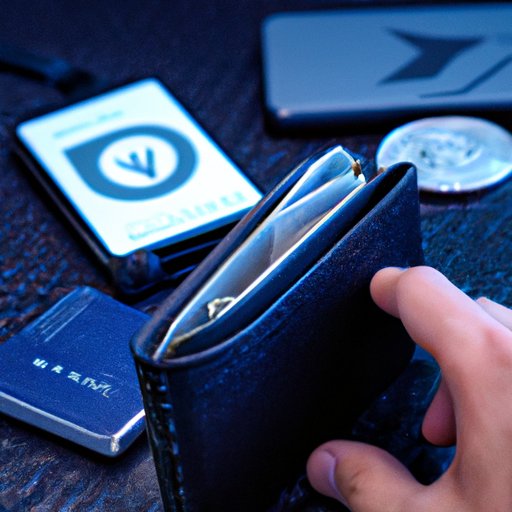Introduction
Cryptocurrencies have become increasingly popular over the past few years, and with their popularity comes the need for a secure way to store them. Cryptocurrency wallets are digital wallets that allow users to store, send, and receive digital currencies like Bitcoin and Ethereum. In this article, we’ll take a look at what cryptocurrency wallets are and the benefits of setting up one. We’ll then provide an in-depth step-by-step guide on how to set up a crypto wallet, as well as tips on how to choose the best wallet for your needs. Finally, we’ll look at the pros and cons of different types of crypto wallets and how to set up a multi-currency wallet.
Definition of Cryptocurrency Wallet
Cryptocurrency wallets are digital wallets used to store, send, and receive digital currencies like Bitcoin and Ethereum. They are similar to traditional bank accounts in that they can be used to store money, but instead of storing fiat currency, they store digital assets. Cryptocurrency wallets come in different forms, including hot wallets, cold wallets, paper wallets, mobile wallets, and desktop wallets. Each wallet has its own unique features and benefits, so it’s important to research and compare them before making a decision.
Benefits of Setting Up a Crypto Wallet
There are many benefits to setting up a cryptocurrency wallet, including:
- Lower transaction fees compared to other payment methods
- Ability to send and receive funds instantly
- Increased privacy and security compared to traditional banking systems
- Access to global markets and opportunities
- Easy access to multiple currencies
Step-by-Step Guide to Setting Up a Cryptocurrency Wallet
Setting up a cryptocurrency wallet is relatively easy, but there are a few steps you should follow to ensure that your wallet is secure and you are getting the most out of your investment. Here’s a step-by-step guide to setting up a crypto wallet:
1. Research Different Types of Wallets
The first step in setting up a cryptocurrency wallet is to research the different types of wallets available. There are several different types of wallets, each with its own set of features and benefits. It’s important to understand the differences between the wallets and decide which one is best suited for your needs.
2. Choose the Right Wallet for Your Needs
After researching the different types of wallets, it’s time to choose the right wallet for your needs. Consider factors such as security features, ease of use, fees, and supported currencies. Make sure to read reviews and do your own research to find the best wallet for your needs.
3. Download and Install the Wallet
Once you’ve chosen the right wallet for your needs, it’s time to download and install it. Depending on the type of wallet you’ve chosen, the installation process may vary. Some wallets require you to download and install software, while others require you to create an online account. Be sure to read all instructions carefully before proceeding.
4. Transfer Cryptocurrency Into Your Wallet
The next step is to transfer cryptocurrency into your wallet. You can do this by purchasing cryptocurrency from an exchange or by transferring cryptocurrency from another wallet. Once the funds have been transferred, your wallet will display the balance.

How to Choose the Best Cryptocurrency Wallet for Your Needs
When choosing the best cryptocurrency wallet for your needs, there are several factors to consider. Here are some of the most important ones:
Security Features
Security is one of the most important factors when choosing a cryptocurrency wallet. Look for wallets that offer strong encryption and multi-signature authentication. Also, make sure to read reviews and do your own research to ensure that the wallet is trustworthy.
Ease of Use
Another important factor to consider is the ease of use. Look for wallets that are user-friendly and intuitive to use. Make sure to read reviews and do your own research to make sure that you’re comfortable using the wallet.
Fees
Most cryptocurrency wallets charge fees for transactions. Make sure to research the fees associated with each wallet before making a decision. Some wallets offer lower fees than others, so it’s important to compare them before making a decision.
Supported Currencies
Finally, make sure to check which cryptocurrencies the wallet supports. Some wallets only support a limited number of cryptocurrencies, so make sure to check which ones the wallet supports before making a decision.
A Beginner’s Guide to Setting Up a Secure Crypto Wallet
Once you’ve chosen the right wallet for your needs, it’s time to set it up securely. Here are some tips for setting up a secure crypto wallet:
Creating Strong Passwords
It’s important to create strong passwords for your wallet. Use a combination of uppercase and lowercase letters, numbers, and special characters. Avoid using common words or phrases, and make sure to change your passwords regularly.
Backing Up Your Wallet
Backing up your wallet is essential for protecting your funds in case of an emergency. Make sure to back up your wallet regularly and store the backup in a safe and secure place.
Using Two-Factor Authentication
Two-factor authentication (2FA) adds an extra layer of security to your wallet. Look for wallets that offer 2FA, such as Google Authenticator or Authy.
Storing Your Private Keys Securely
Your private keys are the most important part of your wallet, so it’s essential to keep them secure. Make sure to store your private keys in an offline storage device, such as a USB drive or hard drive.

What You Need to Know Before Setting Up a Cryptocurrency Wallet
Before setting up a cryptocurrency wallet, there are a few things you should know. Here are some tips to help you get started:
Understanding the Risks
Cryptocurrency is a highly volatile asset, which means that its value can change quickly. It’s important to understand the risks associated with investing in cryptocurrency before setting up a wallet. Make sure to do your own research and consult a financial advisor if necessary.
Knowing the Terms of Service
Make sure to read the terms of service before setting up a wallet. This will help ensure that you understand the rules and regulations of the wallet and that you’re not breaking any laws.
Keeping Your Funds Safe
Finally, it’s important to keep your funds safe. Make sure to use a secure wallet, create strong passwords, back up your wallet, and use two-factor authentication.

The Pros and Cons of Different Types of Crypto Wallets
When choosing a cryptocurrency wallet, it’s important to understand the pros and cons of the different types of wallets. Here’s a quick overview of the different types of wallets and their pros and cons:
Hot Wallets
Hot wallets are connected to the internet and are typically the easiest and most convenient type of wallet. However, they are also the least secure type of wallet as they are vulnerable to hacking and malware attacks.
Cold Wallets
Cold wallets are not connected to the internet and are considered the most secure type of wallet. However, they are more difficult to set up and use, and require additional steps to access and use your funds.
Paper Wallets
Paper wallets are physical documents that contain your public and private keys. They are considered to be the most secure type of wallet, as they are not vulnerable to hacking or malware attacks. However, they are difficult to set up and use, and can be easily lost or destroyed.
Mobile Wallets
Mobile wallets are apps that can be installed on your smartphone. They are convenient and easy to use, but they are also vulnerable to hacking and malware attacks.
Desktop Wallets
Desktop wallets are programs that are installed on your computer. They offer more security than hot and mobile wallets, but they are still vulnerable to viruses and malware attacks.
How to Set Up a Multi-Currency Crypto Wallet
Multi-currency wallets allow users to store and manage multiple cryptocurrencies in one place. Here’s a quick guide on how to set up a multi-currency wallet:
1. Finding a Multi-Currency Wallet
The first step is to find a multi-currency wallet that supports the currencies you want to use. Make sure to read reviews and do your own research to find the best wallet for your needs.
2. Setting Up Your Multi-Currency Wallet
Once you’ve found the right wallet, it’s time to set it up. Follow the instructions provided by the wallet to complete the setup process.
3. Transferring Funds Between Different Currencies
Once your wallet is set up, you can start transferring funds between different currencies. Most wallets allow users to exchange one currency for another, but it’s important to read the terms of service to make sure you understand the rules and fees associated with these transactions.
Conclusion
Cryptocurrency wallets are an essential part of investing in cryptocurrencies, and setting up a wallet is easy and straightforward. However, it’s important to do your own research and understand the different types of wallets and their features and benefits. Make sure to choose the right wallet for your needs, create strong passwords, back up your wallet, and use two-factor authentication to keep your funds secure. Finally, make sure to understand the risks associated with investing in cryptocurrencies before setting up a wallet.
(Note: Is this article not meeting your expectations? Do you have knowledge or insights to share? Unlock new opportunities and expand your reach by joining our authors team. Click Registration to join us and share your expertise with our readers.)
